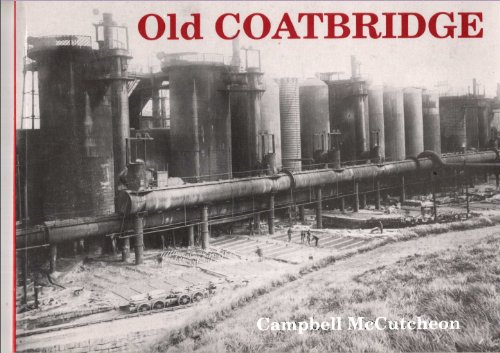Gartsherrie Iron Works
Location type
WorksName and dates
Gartsherrie Iron Works (1828-1967)Served by the Gartsherrie Ironworks and Railways (William Baird & Co).
Served by the Monkland and Kirkintilloch Railway.
Served by the Monkland Canal.
Description
This was a large iron works to the north of Coatbridge. It was built by William Baird & Co in 1828. The location was chosen due to the quantity of blackband ironstone, coal and limestone in the area. The works produced forge quality iron which was internationally famous.
Two banks of eight blast furnaces were built on either side of a specially opened branch of the Monkland Canal. The older bank were to the east. The Monkland and Kirkintilloch Railway ran down the east side of the east bank furnaces. These were charged from the bank to the east and tapped on the canal side to the west, the new furnaces were the reverse - charged from the west. A high level bridge connected the east and west charging sidings over the canal.
Bairds were to become a large concern, owning 42 blast furnaces. At the Gartsherrie site there were to be 16 blast furnaces by 1840.
The works were served by a branch of the Monkland Canal and also by the Monkland and Kirkintilloch Railway of 1826.
The original course of the Monkland and Kirkintilloch Railway through the works was taken over by the company for its own use as it expanded, the railway being relocated just to the east.
There were three access points from the works own private railway network to the railway network at:
- Gartgill Weighs to the north of the works Monkland and Kirkintilloch Railway, later North British Railway approach was from the north
- Gunnie Yard [1st] a connection (the NB owned original course of the M&K) from the yard ran south to a reversing point, by reversal the older original 8 blast furnaces were reached. This was the original connection to the works, the original approach being from the south, later it was by reversal from the north. Even this reversing line was relocated east during rebuilding of the works.
- Gartsherrie Iron Works Signal Box a connection from the Caledonian Railway, allowed departure to the south.
Additionally Gartsherrie New Iron Ore Sidings were laid out in 1959 on the west side of the Caledonian Railway main line in connection with the new single large capacity blast furnace.
The blast furnaces were rebuilt several times, the final rebuild producing a single large capacity furnace in 1960. The size of this furnace, and its being the only one, would lead to long downtimes during relining. The works closed in 1967 and, as often occurs, the furnace dismantled and exported.
Slag was deposited at various locations, originally just east of the works, and area which expanded east. It was also dumped at Kilgarth Slag Hill, in the triangle of lines former by Gartcosh Junction, Gartsherrie South Junction and Garnqueen North Junction. These sidings were on the north side of the west to south curve, accessed from the east - the direction of the iron works. Gunnie Cement was located in the slag processing area east of the works.
Tags
Iron worksExternal links
Canmore site recordNLS Collection OS map of 1892-1914
NLS Collection OS map of 1944-67
11/04/2022
Chronology Dates
| / /1828 | Alexander Baird Construction of Gartsherrie Iron Works begins, a blast furnace on the east side of the Monkland Canal's Gartsherrie branch. |
| / /1828 | Monkland Canal Gartsherrie, Hornock and Summerlee Branch of canal opened, to serve the under construction Gartsherrie Iron Works, Summerlee Iron Works (after 1836) and Howes Basin. |
| 04/05/1830 | William Baird & Co Production starts of first hot blast furnace at Gartsherrie Iron Works. |
| /11/1830 | William Baird & Co Cold blast used due to technical problems at Gartsherrie Iron Works (unable to warm the blast using the heat above the open topped furnace). |
| /10/1831 | William Baird & Co Hot blast re-introduced at Gartsherrie Iron Works (blast warmed at ground level). |
| 11/09/1832 | William Baird & Co Second blast furnace in operation at Gartsherrie Iron Works. |
| / /1843 | William Baird & Co 16 blast furnaces now in operation at Gartsherrie Iron Works with an annual capacity of 100,000 tons, 8 new blast furnaces opened on the west bank of the Monkland Canal's Gartsherrie branch. |
| / /1846 | Monkland and Kirkintilloch Railway Formation of line at Howes re-modeled further east at Sunnyside Junction to allow expansion of William Baird & Co's Gartsherrie Iron Works. William Baird & Co was the contractor for the work. |
| / /1878 | William Baird & Co Blast furnaces at Gartsherrie Iron Works start being re-built. |
| / /1896 | William Baird & Co Blast furnaces at Gartsherrie Iron Works all re-built and by-products plant installed. |
| / /1939 | William Baird & Co William Baird & Co absorb the Scottish Iron and Steel Company to create Bairds and Scottish Steel. This linked the Gartsherrie Iron Works with the Northburn Steel Works. There was no hot metal road between the works. |
| / /1963 | William Baird & Co Decline to buy back the Gartsherrie Iron Works post nationalisation. |
| / /1967 | William Baird & Co Former possession Gartsherrie Iron Works closed, although its associated concrete works remained open. |
| /01/1967 | National Coal Board Dumbreck Colliery and its Dumbreck Coke Ovens closed when the Mossend ICI Ammonia Plant closed (coke ovens need ammonia). Demand for coking coal had reduced with the closure of Gartsherrie Iron Works. |









